|
< Earlier Kibitzing · PAGE 6 OF 7 ·
Later Kibitzing> |
| Apr-10-13 | | lost in space: <<Eyal:> <It seems to me that 18. Bd2 Nxd4 19. Nxd4 Bxd4 20. Bb4 f3 21. Qc2 fxg2 22. Rh5 Rxf2 23. Bxh7+ Kh8 24. Be4+ is an alternative, or?>
First, it's a draw, and at this stage Aronian was apparently still playing for a win; but White may actually improve here with 22.Rf5. However, Black is better after 19...Qxc5 (instead of Bxd4) 20.Qxe6+ (20.Nxe6 Qc6 21.Qg4 Rf7) 20...Rf7 (20...Kh8 21.Qh3 h6 22.Ne6) 21.Bxh7+ Kxh7
22.Qxf7 Qxd4 23.Qxb7 Rd8! 24.Qf3 (24.Qxa6 Qxb2 & Qc2) 24...Qd5! and now 25.Qxf4 loses to 25...Bg5 and after a queen exchange White would lose his Q-side pawns> Had a closer look to 19...Qc5 20. Qxe6 Rf7 21. Bxh7+ Kxh7 22. Qxf7 (line given above as possible improvement over 19...Bxd4) 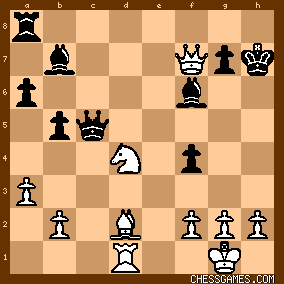
click for larger viewYes, this is even better for Black.
For example: 22...Qxd4 23. Qxb7 Rd8 24. Qf3 Qd5! 25. Qg4 (reasons and sideline already given by <Eyal> 25...Kg8 26. Qg6 Qd3 27. Qxd3 Rxd3 28. Kf1 f3 and Black is winning. 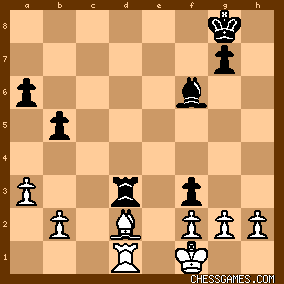
click for larger view |
|
| Apr-10-13 | | Just Another Master: Nerves just dissolved... Aronian doesnt have the nerves to be the best, no insult, few have them. |
|
Apr-10-13
 | | chancho: This game was played in the 12th round of a round robin tournament where each player is in the top twenty, and rated 2700 and up. (Cat 22)
By the time this game was played, Aronian's creative juices were being affected by exhaustion. 50.g6 was awful. |
|
| Apr-10-13 | | Ulhumbrus: After 20...Rac8 what does Black do after 21 Be4? |
|
| Apr-10-13 | | Eyal: 20...Rac8 21.Be4 Nxd4! wins for Black (22.exd4 Rxc5 23.dxc5 Bxe4). <Hesam7> analyzed this line on p.4. |
|
| Apr-11-13 | | Ulhumbrus: <Eyal: 20...Rac8 21.Be4 Nxd4! wins for Black (22.exd4 Rxc5 23.dxc5 Bxe4). <Hesam7> analyzed this line on p.4.> Thx. As I say, if the attack gains no more than a draw White cannot be satisfied with such a result from the opening and he has to seek alternatives earlier. |
|
| Apr-11-13 | | lost in space: Position after 20...Ne7?
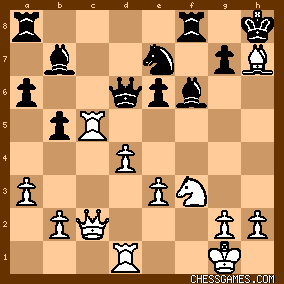
click for larger viewYes, as pointed out by others 20...Ne7? was a very bad move - now White has advantae and even chances to win. Before this move it was vice versa Here White has the following line:
20. Rh5 Rac8 22. Qe2 g6 23. Bxg6+ Kg7 24. Bb1 Kf7 25. Ne5+ Ke8 27. Rh7 and white is more than fine - for me it seems winning.
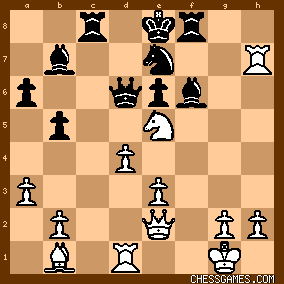
click for larger viewChecking now 22...Bxf3 which I found in one of <Eyal>'s post and will come back later with the result |
|
| Apr-12-13 | | lost in space: Position after 20..Ne7 21. Rh5 (not played in the game) Rac8 22. Qe2 Bxf3 (instead of 22...g6) 23. Qxf3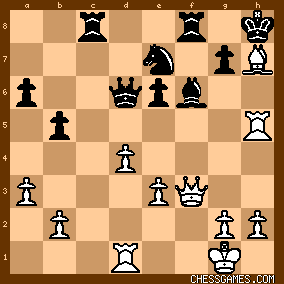
click for larger viewAccording to <Eyal> Kramnik though about 23...Ng8. I checked this posiiton with shredder 12 on d=23 and this is the result: A: +0,65; 23...Bg5 24. Bb1+ Kg8 25. Qh3 Bf6 26. Rh8 Kf7 27. Qh5+ g6 28. Qh7+... B: +0,96; 23...g5
C: +2,76; 23...g6
23..Ng8 is not on the top 3 list. The reason is simply and already given in the post of Eyal: After 23...Ng82 4. Bb1+ Nh6 25. Qe4 Kg8 26. Rxh6 Black is lost. |
|
| Apr-12-13 | | Eyal: <20..Ne7 21. Rh5 (not played in the game) Rac8 22. Qe2 Bxf3 (instead of 22...g6) 23. Qxf3 According to <Eyal> Kramnik though about 23...Ng8.> Not quite - I said Kramnik mentioned 21.Rh5 Rac8 <22.Qd3> Bxf3 23.gxf3 Ng8 as good for Black (which it is), using it as a reference point to explain why 22.Qe2 is better for White in this line. |
|
| Apr-12-13 | | lost in space: Position after 21. e4
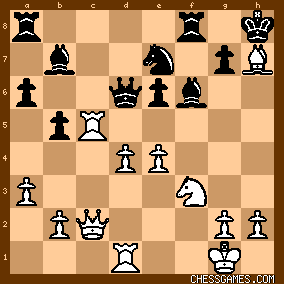
click for larger viewAronian missed 21. Rh5, with the consequence that Kraminik is in the lead again. But once again he missed the best move here. After 21...Qf4 22. Rh5 Ng8 23. Qc1 Qxc1 24. Rxc1 Nh6 25. Bg6 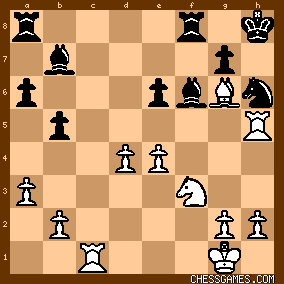
click for larger viewand White has noting and is lost.
After the second best move 21...Rac8 22. e5 a long forced sequence lead us to this position (after move 28) 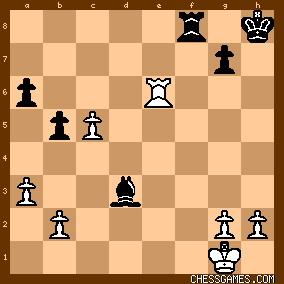
click for larger viewHere I will have a closer look |
|
| Apr-12-13 | | Eyal: 
click for larger viewBlack was probably winning anyway in the long run, but here 30.c6? should have allowed him a rather elementary win by 30...Rc8! with the idea of continuing Bc4-f7-e8 and collecting the c-pawn. Instead, with 30...Rf1+?-31...Rc1 Kramnik allowed Aronian to reach a drawn position by forcing the rook exchange, and then we all know what happened on move 50... |
|
| Apr-13-13 | | lost in space: I agree with <Eyal>s analyze of the moves 30. c6?, 30...Rf1? 30. Rc8! Seems that all knows what exactly happened on move 50 beside me. So I will have a look |
|
| Apr-14-13 | | lost in space: Position after 43. Kd7

click for larger viewHere there is 44. c8=Q+ Kxc8 45. h6 Bg8 46. Kf5 gxh6 47. gxh6 
click for larger view and the game is a clear draw. White has to keep a black king out of his camp, so not Kg6 and h7 but lets say 47...Kd7 48. Ke5 Ke7 49. Kd4 Kf6 50. h7! Bxh7 51. c4 
click for larger view.
So Aronians 44. Ke5 is not worse compared to the line given above - as I though first. |
|
| Apr-14-13 | | lost in space: In think nobody can explain the 50th move from Aronian. He seems to have completely understood the endgame (in opposite to me) and then this blunder - Even I bloody patzer saw that it is a mistake. So: a very, very good game in all phases with errors on both sides and a terrible blunder at the end. Too bad. |
|
| Apr-14-13 | | polarmis: <lost in space: In think nobody can explain the 50th move from Aronian.> It's hard to resist giving Kramnik's explanation :) http://chess-news.ru/node/11625 (it's possible some of the transcription/translation of what Kramnik said isn't perfect, but it should give the gist!) <I calculated the ending, but I don't agree with all these assessments. You see everyone's sitting there with a beer on the table and an engine switched on, and they're amazed that someone didn't play that... In actual fact it's not so simple because all the lines there are 20 moves long. But while Levon was thinking - he spent 40 minutes - I was sitting there and calculating all those variations.What I can say is that first of all, the tension was immense and secondly, tiredness was a factor - the game had already been very tense up until that point. Of course it was also tricky, and you need to take that into account. The third very important point is that you have to realise that we didn't have any engines on hand, and we didn't know if it was won, lost or whatever. And that makes the task much tougher. Eventually I calculated everything correctly. I said to him straight after the game: "Why didn't you play h6?". But you needed to grasp why h6 was necessary rather than simply giving up the pawn. Otherwise I would take on g5 and return with the king. I don't take with the king on h5, which is a draw, but play Kf6 - and win. The move h6 is necessary precisely to deflect the king so it takes on h6. And after that there are very many variations - you can push the c-pawn, push the a-pawn without the c-pawn or push the a and c-pawns together. It's easy to get confused. I can tell you how it was for me - while Levon was thinking I was calculating and I kept going wrong. Sometimes I'd be in time, sometimes I'd be a tempo short. I was even starting to get annoyed with myself, because I just couldn't calculate it all neatly to the end - is it a draw or do I win? The same variation would be "I'm in time", and "I'm not in time". You lose track a little. But then, in the end, about 5 minutes before Levon played g6, it seems I'd calculated it all accurately, and yes, it seemed to me that h6 led to a draw. I couldn't see any other draw. But g6... Actually, what's the idea? Levon also couldn't manage and got confused - he told me after the game that he couldn't calculate it to the end and played g6 with the idea that when I took the pawns the king would slow down the g-pawn. But actually he'd miscalculated. It's true that it slows down the g-pawn, but the king is just in time to return to the other flank. On the other hand, if I'd slightly miscalculated, if I was just slightly not in time, then it wouldn't simply be a draw but I'd have lost after g6. I've got no doubt that in his fresh, normal state Levon would of course have calculated that. But after all, there were nerves and the total exhaustion at the end of the tournament. Again - it's not a trivial calculation. It's quite direct, but the variations are very, very long. Therefore that mistake can be explained, it wasn't something totally crazy like mate-in-one, as I once blundered. After the game he said that he couldn't calculate it to the end either - it seemed to him that after h6 I would queen quicker, but in actual fact we'd queen simultaneously. But here you need to take into account the condition of exhaustion which influenced him to make such a big blunder.> |
|
| Apr-14-13 | | micartouse: <polarmis> Your translating is much appreciated, thank you. <I calculated the ending, but I don't agree with all these assessments. You see everyone's sitting there with a beer on the table and an engine switched on, and they're amazed that someone didn't play that... In actual fact it's not so simple because all the lines there are 20 moves long.> Haha this certainly belongs on the syllabus for Chess Appreciation 101. |
|
| Apr-14-13 | | Eyal: <You see everyone's sitting there with a beer on the table and an engine switched on, and they're amazed that someone didn't play that...> It should be noted that Short & Trent, who analyzed h6 to a forced draw during the live broadcast a while before the critical position was reached, were actually sitting with a coke on the table and weren't using an engine; however, they did move the pieces around... |
|
| Apr-14-13 | | polarmis: I think it's probably relevant that even if they didn't have the exact computer analysis they could see the Chess Casting evaluation was a draw - so knowing the "result" it's easier to fill in the gaps. Having said that, I was very impressed with how much Short/Trent saw in that game! |
|
| Apr-15-13 | | lost in space: <<polarmis:> <lost in space: In think nobody can explain the 50th move from Aronian.>
It's hard to resist giving Kramnik's explanation :) http://chess-news.ru/node/11625 (it's possible some of the transcription/translation of what Kramnik said isn't perfect, but it should give the gist!)> Well, I can at least undersdand the argumentation of Kramnik. I really tried hard to understand the complete game - together with a comp as I am not good enough without. From my perspective the ending was complicated - very complicated long before move 50. But I had the impression that Arionian had an excelent understanding of the ending. Moves like 44. Ke5 are so hard to spot and it takes long to get it (at least for me). The position after 40 moves was much less complicate compared to the posiiton 10 moves ago - after having done all the analyis before I quickly saw that h6 is a draw - without the help of a computer. So yes, I had the help of a computer but this is just to understand the deepnes of this game. And yes, it is easy to sit there having no pressure, knowing that at d=22 the evaluation is 0,00. But: If I bloddy patzer are able to see that 50..h6 is a draw I think Arionian should see it in a second even when halfly sleeping. Still I think it is a great game, but with a terrible blunder at the end. |
|
| Apr-16-13 | | Ulhumbrus: <lost in space: ...Well, I can at least undersdand the argumentation of Kramnik. I really tried hard to understand the complete game - together with a comp as I am not good enough without. > This game may have changed the theory of this opening variation. Aronian loses a tempo on moving a pawn in the opening by 8 a3?! whereupon after 10...f5!! White lacks a tempo needed to take advantage of the potential weakness of Black's e5 and e6, and instead White's d4 comes under attack. |
|
| Apr-16-13 | | Petrosianic: <lost in space>: <In think nobody can explain the 50th move from Aronian.> It's been explained numerous times. Aronian picked the move that would require White to spend the maximum time picking off his pawns. He must have thought that White's King would be too far away afterwards for it to matter that the king was closer after g6 than it would have been after h6. It very nearly was, as can be seen by the trap at Move 57. <Even I bloody patzer saw that it is a mistake.> If we're going to just GM moves by whether or not a patzer would play them, then I'm afraid we'll have to throw most of them out. You may not be grasping just how dangerous White's queenside pawns were. We had this discussion before, but in Fischer-Spassky, Game 1, even a lot of patzers saw that Bxh2 was a bad move. But a lot of them didn't really understand why it was (they thought Fischer had overlooked g3, when in fact his error came several moves deeper into the line). g6 is certainly a counter-intuitive move that few patzers would have played, but I'll bet very few could give a rigorous explanation as to why it was wrong. |
|
| Apr-16-13 | | Eyal: <Aronian picked the move that would require White to spend the maximum time picking off his pawns.> The picking off itself takes three moves in both cases: Kg5-Kxh5-Kxg6 in the game, g6-Kxg5-Kxh6 if 50.h6. But in the former case it might seem that White is gaining time - especially if one thinks about it as a pawn race - because the black king ends up blocking his g-pawn. This is confirmed by what Kramnik himself said in that bit of interview quoted above by <polarmis>: <But g6... Actually, what's the idea? Levon also couldn't manage and got confused - he told me after the game that he couldn't calculate it to the end and played g6 with the idea that when I took the pawns the king would slow down the g-pawn.> But as he goes on to say, <actually he'd miscalculated. It's true that it slows down the g-pawn, but the king is just in time to return to the other flank.> A line which illustrates this more "dramatically" than the one actually played in the game is 54.c4 (instead of a6 – to prevent Bd5) Bh7 55.a6 Be4 56.c5 Ke7! (not 56…Ke6? 57.Kc5!) 57.c6 Kd6 58.a7 Bxc6+ getting control of a8. |
|
| Apr-16-13 | | Petrosianic: <But in the former case it might seem that White is gaining time - especially if one thinks about it as a pawn race -> Exactly. I may not have explained it fully, but after g6, it takes White an extra move to pick off the pawns AND clear the way for his g pawn to start moving than it would have if he'd played h6. The difference is that after g6, Black's king is closer to the action than it would have been after h6. But if it's too far away in both variations, this doesn't matter. The mistake is that in fact Black's King <wasn't> too far away after g6. But it takes a lot of calculation to see that. No patzers just intuitively knew it. |
|
Apr-16-13
 | | AylerKupp: <<lost in space> Position after 43....Kd7 44.c8=Q+ Kxc8 45.h6 Bg8 45.Kf5 gxh6 47.gxh6 and the game is a clear draw>

click for larger viewIt is indeed a draw after 47...Kd7 as you indicated but I thought that after 47...Bh7+ that it might not be. White has 2 options: (1) Keep the king on the k-side and force Black to give up his bishop to prevent the h-pawn from queening. But I then thought that Black had enough time to pick off White's q-side pawns. But after 47...Bh7+ 48.Kf6 Kd7 49.Kg7 Bb1 (or any other bishop move along the b1-h7 diagonal other than 49...Bg6) 50.h7 Bxh7 51.Kxh7 and Black mates in 18 moves per the 6-piece Nalimov tablebases. (2) Move the king to the q-side and protect his q-side pawns. This works out better after 47...Bh7+ 48.Ke6 Kc7 49.Kd5 Bb1 50.Kd4 Kc6 51.h7 Bxh7 52.c4 (the key move!). And now if either 52...bxc4 53.Kxc4 or 52...b4 53.axb4 it's a draw per the 6-piece Nalimov tablebases. Black's problem is that after 52.c4 bxc4 53.Kxc4 his bishop does not control the a-pawn's queening square, so even if White lost his a-pawn the position would still be a draw. And after 52.c4 b4 53.axb4 a3 54.Kc3 White's king can get to a1 so even if White loses both his remaining pawns the position is still a draw. I want to let you (and others) know about a nifty program developed by Pedro Pérez Romero called FinalGen. It is basically a tablebase generator for positions consisting of kings, one piece for each side, and any number of pawns. So it could theoretically determine the results of positions containing up to 20 pieces; two kings, two pieces, and 8 pawns per side. I said "theoretically" because there are positions that meet its basic requirements but are too complex for the program to analyze. Other positions can theoretically be analyzed but are not practically possible because they will require weeks of analysis and 10s of TB of storage. It all depends on the mobility of the pawns; if the pawns are far advanced or blocked then the number of possible pawn moves is much smaller than if the pawns were near their original squares and had full freedom of movement. Still, for many positions the program can come up with definitive results beyond the capabilities of the 6-piece Nalimov tablebases and 7-piece Lomonosov tablebases. These were the results of its analysis of the position after 47.gxh6. It took FinalGen 00:29:23 minutes and required about 28 GB of disk space (I added the move numbers myself): 47...Ba2 Draw
47...Bb3 Draw
47...Bc4 Draw
47...Bh7+ Draw
47...Kd7 Draw
47...Kb7 Draw
47...Kc7 Draw
47...Kb8 Draw
47...Kd8 Draw
47...b4 White wins in 28
47...Bd5 White wins in 3
47...Be6+ White wins in 3
47...Bf7 White wins in 3
Of course, even I as Black would not play any of the last 3 moves but it does show that the program is thorough. But for the other moves you can then ask the program to display the lines that make up the principal variation for each move, and you can explore the side variations. You can download FinalGen from here: http://www.mtu-media.com/finalgen/h.... And best of all, at least for the moment, it's free. |
|
Apr-16-13
 | | AylerKupp: <<Petrosianic> ... even a lot of patzers saw that Bxh2 was a bad move. But a lot of them didn't really understand why it was (they thought Fischer had overlooked g3, when in fact his error came several moves deeper into the line).> No, Fischer's mistake was 29...Bxh2, not later, and his game was lost against best play by Spassky from that point forward. See my analysis (with a "little help" from Rybka 4.1) starting at Spassky vs Fischer, 1972 and continuing through most of p.17. If you can find any errors in it or other lines that might allow Fischer to salvage a draw after his mistake, please let me know. I would really like to see them. But, of course, Fischer didn't overlook 30.g3, he just miscalculated and thought that he could get away with 29...Bxh2. And it wasn't easy to show that he couldn't! |
|
 |
 |
|
< Earlier Kibitzing · PAGE 6 OF 7 ·
Later Kibitzing> |





